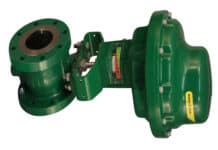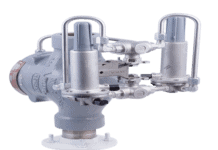
Emerson’s Rosemount 9195 Wedge Flow Meter is a fully integrated solution consisting of a wedge primary sensor element, supporting components, and a selectable Rosemount pressure transmitter. It is designed to optimize performance in applications with high-temperature, high-viscosity, or abrasive liquids, while reducing lifecycle costs. The new meter’s unique flexible design is ideal for measuring process fluids with a wide range of demanding characteristics in various heavy industry applications, including metals and mining, oil and gas, renewable fuels, chemicals and petrochemicals, pulp and paper, and others.
It can be very difficult to measure volumetric flow accurately and reliably in applications where the process liquid is highly viscous, extremely abrasive, prone to plugging, at high temperature, or a combination of these conditions. In applications with low ambient temperatures, hot process media, or a combination of both, heat tracing is often required, necessitating supply of electrical power, and creating a maintenance-intensive single point of failure.
The Rosemount 9195 Wedge Flow Meter addresses these and other common measurement challenges with its unique design. The wedge element itself has no small passages that could plug due to entrained particles, and it is abrasion-resistant due to the shallow approach angle of the process liquid and the lack of critical sharp edges. Highly viscous liquids are measured accurately due to the linear response of the meter, even at low Reynolds numbers.
The sensor’s operating temperature range is -40 to 1,000 degrees Fahrenheit (-40 to 538 degrees Celsius), and the meter is available with Emerson’s Rosemount 3051S Thermal Range Expander for measuring hot or viscous liquids, without the need for heat tracing.
Two-way digital connections from the selected pressure transmitter to a host, such as a distributed control or an asset management system, can be made via 4-20 mA HART, WirelessHART, FOUNDATION Fieldbus, Modbus, or BSAP/MVS. Depending on the selected transmitter, a wide range of process variables can be sent to host systems for process control and monitoring, diagnostics, and other purposes.
Application flexibility is provided with three sensor/transmitter connection styles:
- Compact: Reduces pipe standoff to address plugging and cleaning concerns. Saddle-style remote seal connection reduces the weight of the meter by 50%.
- Flanged: Incorporates a 2-inch NPS/DN50 connection. This traditional style is used if flushing rings and valve assemblies are required.
- Threaded: Incorporates a ½ inch NPT connection with tubing, ideal for applications where plugging is less of a concern than erosion or wear.
To simplify ordering and ensure the correct remote seal system is specified, five optional application packages—including standard, abrasive, ultra-high process temperature, cold environment, and remote mount—are available for the sensor element.
Available line sizes for the sensor are 2-inch to 8-inch (50 to 200 millimeters). All wetted materials are 316L stainless steel, and the meter complies with ASME B31.3 and CRN safety standards. Additional materials and sizes can be accommodated upon request.





















![[VIDEO] Collect Asset Data at the Speed of Walking a Building](https://facilityexecutive.com/wp-content/uploads/2024/02/maxresdefault-324x160.jpg)